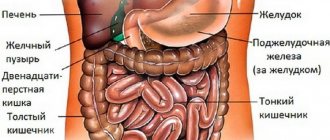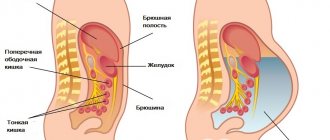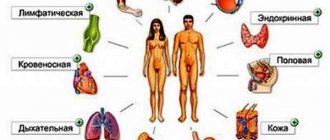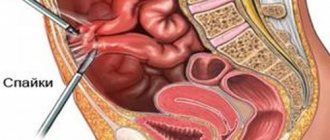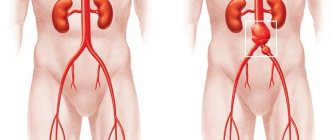Abdominal pain (in the abdomen) is quite common in both adults and children. Many people try to associate them with some food or drink consumed the day before. This reason for the development of events also occurs, but not always.
Abdominal pain can also be caused by more serious factors. One of them is that the lymph nodes in the abdominal cavity are enlarged. In children and adults, the symptoms of this pathology are approximately the same. The difference is that a small patient sometimes cannot explain clearly enough what is wrong with him. Concerned parents may attribute his complaints of abdominal pain to a dozen reasons that have no place in this case. Some even begin to self-medicate, thereby aggravating the baby’s condition.
The article answers questions about why a child may have enlarged lymph nodes in the abdominal cavity, how to differentiate this pathology from other problems with the gastrointestinal tract, and what treatment is required.
Lymph nodes
First, let's take a brief overview of these small but very important organs. The lymph node is a natural filter that helps get rid of all kinds of pathogenic agents that have entered the body.
Its structure is quite complex. In general terms, a lymph node is a small (up to 50 mm maximum) round, bean-shaped or oval-shaped sac, to which lymph vessels (several incoming and one outgoing) are suitable. The outside of the “bag” is covered with a membrane consisting of connective tissue. Inside it is filled with the so-called stroma, made up of reticular fibers. A large number of lymphocytes of various types are concentrated in the space between them.
Lymph, slowly seeping through the reticular fibers, as if through a sieve, is cleared of all sorts of pathogenic agents that it has “collected” in the body (bacteria, viruses, protozoa, and so on). If a person has any disease, too many harmful elements enter the lymph. The lymph nodes can no longer cope with their task and become inflamed. This symptom always indicates the presence of some pathogenic process in the body.
While examining the patient, the doctor discovers that his lymph nodes are enlarged. In the abdominal cavity of a child and an adult, there are about 600 of them. They are located not one by one, but in groups, vaguely similar to a bunch of grapes. Lymph nodes are concentrated in the peritoneum where blood and lymph vessels pass - near the stomach, liver, spleen, mesentery, intestines.
Features of the abdominal lymph nodes
The main feature of the abdominal lymph nodes is their location. Mesenteric lymph nodes are located in the peritoneum, so they cannot be palpated. They ensure the drainage of lymph from the abdominal organs, protecting against infection, removing toxins and ensuring the normal functioning of the immune system.
With inflammation of the abdominal lymph nodes, it is difficult to make a diagnosis on your own. This is due to the fact that the symptoms are more reminiscent of an intestinal infection or flu with dyspeptic disorders. Children under 12-13 years of age are more likely to experience inflammation of the lymph nodes of the abdominal cavity and retroperitoneal space than adults, which is explained by the weak immunity of the child’s body.
Having understood what mesenteric lymph nodes are, we should take a closer look at their location and functions. Pathologies of this group of lymph nodes are dangerous due to complications. In addition, this group of lymph nodes reacts sharply to oncological pathologies of internal organs, so it is important to be able to identify dangerous symptoms in a timely manner, but not to brush off the discomfort, expecting that it will go away without treatment.
Location and functions
Symptoms of the acute stage increase over 1-5 days depending on the person’s immunity; in young children it develops within a few hours
The location of the lymph nodes in the abdomen is quite confusing, since they are a large conglomerate of organs of the lymphatic system located in the peritoneum, in the lower abdomen, near all abdominal organs and along the aorta.
The main groups of abdominal lymph nodes:
- mesenteric lymph nodes,
- para-aortic lymph nodes,
- paracaval lymph nodes,
- parapancreatic nodes.
All these lymph nodes are combined into one large group - the retroperitoneal lymph nodes. The mesenteric lymph nodes provide lymph drainage from the posterior wall of the abdomen and intestines. Enlargement of mesenteric lymph nodes in adults and children is an alarming symptom that can appear against the background of various pathologies.
The para-aortic lymph nodes of the intra-abdominal region are located along the aorta.
Paracaval lymph nodes are located near the inferior vena cava.
All lymph nodes located near the pancreas, liver and gallbladder are called parapancreatic.
The functions of this group of lymph nodes are filtration of intercellular fluid (lymph), removal of toxins and infectious agents. Lymph nodes act as a filter, ensuring the normal functioning of the abdominal organs and the entire body as a whole. They are an important component of the human immune system, and therefore react acutely to episodes of decreased immunity.
Normal sizes
Lymph nodes in the abdomen of women, men and children are located the same, but their exact number is unknown. In general, the number of lymph nodes is an individual physiological feature; exact norms have not been established. For example, the number of celiac lymph nodes ranges from 9 to 15.
The size of the lymph nodes is another physiological feature. So, on average, mesenteric lymph nodes do not exceed 10 mm in diameter.
It is believed that the normal diameter of the lymph node is from 3 to 15 mm. At the same time, in humans, some nodes can reach 50 mm in diameter, which will not be considered a deviation from the norm. As a rule, internal lymph nodes are much smaller than superficial ones.
Each abdominal lymph node has an individual size, but the norm will depend on where it is located. Thus, the splenic nodes are quite small and are rarely more than 5 mm in diameter. Para-aortic lymph nodes can reach 10 mm, but mesenteric lymph nodes are most often also small in size - about 3-7 mm.
The normal sizes of lymph nodes in children are the same as in adults. It is worth noting that in children under 3-5 years of age, the lymph nodes are always slightly enlarged, which is due to the peculiarities of the child’s immune system.
Causes of inflammation
Based on the above, you can easily understand why the lymph nodes in the abdominal cavity of a child are enlarged. In general, this condition is called lymphadenopathy, and inflammation of the lymph nodes specifically in the mesentery is called mesadenitis. It is caused by the following reasons:
- Any bacterial infection (streptococci, staphylococci, salmonella, tuberculosis, E. coli).
- Any viral infection (enterovirus, herpes).
- Worm infestation.
- Fungal infection.
- In rare cases, toxic poisoning.
Pathogenic elements enter the lymph nodes with blood, lymph, and also through the lumen of the tract (worms).
Sometimes the infection seeps into the tissue of the lymph nodes directly from the intestines.
What diseases cause mesadenitis?
Most often, a child's lymph nodes in the abdominal cavity are enlarged due to the development of diseases in the organs near which they are located. Among them:
- Helminthiases.
- Brucellosis.
- Hepatitis.
- Trichinosis.
- Ascariasis.
- Echinococcosis.
- Salmonellosis.
- Mononucleosis.
But often the lymph nodes in the child’s abdominal cavity are enlarged due to infectious diseases not related to the gastrointestinal tract. Among them:
- Flu.
- ARVI.
- Tuberculosis.
- Pneumonia.
- Herpes.
- Lupus erythematosus.
The following can also cause enlargement of lymph nodes in the peritoneum:
- AIDS.
- Syphilis.
- Malignant formations (metastasis in the gastrointestinal tract).
These ailments are mainly observed in adults, but they also occur in children.
Predictions and prevention
An enlargement of the lymph nodes in the peritoneum in a child and a correct diagnosis detected in the early stages help to cope with the problem before dangerous complications arise. Unfortunately, in practice, enlarged lymph nodes are not detected immediately. Often the patient does not suspect that he has such an illness. Pathology is detected by chance during any examination of the gastrointestinal tract. Delayed detection worsens prognoses.
Self-medication when symptoms of inflammation of the lymph nodes occur can result in the death of the child.
The following measures can be used to prevent mesadenitis and lymphadenopathy:
- Vaccinations (eg, flu, hepatitis).
- Timely detection and treatment of the underlying disease.
- Proper nutrition.
- Strengthening the immune system.
- Hardening.
- Hygiene.
Such measures can reduce the risk of many infectious diseases, such as influenza, ARVI, helminthiases, which cause enlarged lymph nodes in the peritoneum.
source
Classifications
A disease in which the lymph nodes in the child’s abdomen are enlarged can occur suddenly or last for years. Depending on the nature of the flow, the following forms are distinguished:
- Spicy.
- Chronic.
Depending on the number of enlarged lymph nodes, the following forms are distinguished:
- Local (affects one node).
- Regional (more than one lymph node is enlarged).
- Generalized (the entire peritoneum is affected).
Based on etiology, the following forms are distinguished:
- Primary (occurs as an independent disease).
- Secondary (occurs against the background of infections in the gastrointestinal tract, respiratory tract and others).
Features of axillary lymphadenopathy
Medical diagnoses are often not very clear to the uninitiated: is it dangerous or not dangerous, can you just take pills or is surgery necessary, what is the mediastinum or what is it - axillary lymphadenopathy of the mammary gland, many such questions arise.
Lymphadenopathy of the axillary lymph nodes is a condition in which the lymph nodes located deep in the breast tissue change their size and structure and become fused to each other or to the skin:
- Axillary lymph nodes are located in the breast area, inside and outside the axillary fossa. This is where the largest number of them are concentrated.
- The axillary lymph nodes play an important role in cleaning the lymph coming from the upper extremities, chest, and mammary glands.
- Axillary nodes located in the mammary gland are most prone to pathology. Changes in the size and structure of the axillary nodes are called axillary lymphadenopathy.
- Axillary lymphadenopathy most often indicates an advanced oncological disease and the impossibility of solving the problem in a conservative way. Lymphadenopathy of the axillary lymph nodes is the first sign of the metastasis process. The location of the inflammation indicates unilateral or bilateral lymphadenopathy.
Enlarged lymph nodes in the abdominal cavity in a child: symptoms
In children, the acute form of the pathology is more often diagnosed. It is characterized by a violent manifestation. Its manifestations are as follows:
- A sharp increase in temperature.
- Complaints of abdominal pain (paroxysmal, acute, localized or vague).
- Children's anxiety, tearfulness, moodiness.
- Vomit.
- Complaints of nausea.
- Diarrhea (this symptom often makes parents think that the child has eaten something wrong).
- Palpation of enlarged lymph nodes.
In the chronic form, all these symptoms are less pronounced. Also, with a long course of the disease, in which the child has enlarged lymph nodes in the abdominal cavity, the stomach hurts in the navel area or the pain spreads to the lower sections. Sometimes children have difficulty explaining exactly where it hurts, since the unpleasant sensations are vague and palpable throughout the entire abdominal area.
Symptoms of lymph node changes
An increase in the size of parts of the lymphatic system occurs quickly and is accompanied by pronounced symptoms:
- sharp pain in the upper abdomen or in the navel area, the inability to accurately indicate the location of the symptom;
- the pain may be mild, intensified by coughing or changing body position, and does not go away on its own for a long time;
- persistent pain with increased inflammation;
- nausea, vomiting no more than 1-2 times, rare diarrhea, dry mouth;
- general deterioration in health, increased heart rate and temperature rise to 39 degrees.
Lymphadenopathy can become chronic, in which case most of the symptoms become less pronounced. Pain will appear mainly during active physical activity and movement.
Tuberculous mesadenitis
According to medical statistics, enlarged lymph nodes in the peritoneum are more often observed in children aged 6-14 years. In view of this, the occurrence of such a condition due to infection with Koch bacilli (tuberculosis form) is diagnosed in rare cases. It occurs due to the fact that pathogenic bacilli from the lungs enter the lymph, and with it are carried into the lymph nodes of the peritoneum. In this case, the following signs of inflammation are observed:
- The child becomes indifferent to games and lethargic.
- Lost appetite.
- There is weight loss.
- I am worried about a cough that cannot be treated with classical methods.
- The skin becomes pale.
- The temperature stays between 37.1-37.3 degrees Celsius.
If the lymph nodes in the child’s abdominal cavity are enlarged precisely because of suspected tuberculosis, what should be done? First of all, you need to perform a test for the presence of Koch bacilli in the blood. It is better known as the Mantoux reaction.
Nowadays, you can catch tuberculosis anywhere - in transport, in child care institutions, during public events. At risk are children whose family members suffer from this disease, as well as those children who have undergone any disease or surgery after which their immunity has decreased. Parents of such children should immediately consult a doctor if the child develops the above symptoms.
Lymphadenopotia - mechanism of occurrence
Even a slight increase in lymph nodes in the human body is an alarming signal, since this indicates the occurrence of a pathological process inside the body.
Lymph nodes are unique indicators. Pathogenic agents entering them cause a response, increased production of lymphocytes. As mentioned earlier, enlarged lymph nodes are not a disease, but the chronic course of the inflammatory process can lead to the development of severe complications. Most often, with lymphadenitis, an acute course of the disease is observed. The affected node becomes larger, palpation causes pain, the skin over the surface of the lymph node is hyperemic, and the local temperature rises. These symptoms are quite indicative and require immediate medical attention.
https://www.youtube.com/watch?v=L6m0fV4Y4l8
Mesenteric lymph nodes
As for mesenteric lymph nodes, their diagnosis is difficult. Since they are located in the peritoneal cavity, inflammation in them cannot be diagnosed without laboratory tests and instrumental procedures.
The difference between mesadenitis and appendicitis, gastritis and other gastrointestinal diseases
Symptoms such as abdominal pain, nausea, loss of appetite, weakness, fatigue, stool upset (diarrhea/constipation) are observed in most diseases of the gastrointestinal tract. Therefore, it is almost impossible to make a diagnosis based on clinical manifestations alone. This is especially true if the patient is a small child who cannot really explain anything. The following characteristic signs can help in making a preliminary diagnosis:
- With gastritis, discomfort intensifies after eating. Also (in addition to the signs of mesadenitis listed above), patients may experience flatulence, heartburn, and belching. With inflammation of the lymph nodes, there are no such symptoms.
- With appendicitis, sharp pain is most often localized in the right side of the peritoneum (in the iliac region). Palpation of this area causes muscle tension and increased pain. Another sign is that the temperature in the rectal area differs from that measured in the armpit by 1 or more degrees. There are a number of syndromes by which an experienced doctor can distinguish appendicitis from inflammation of the lymph nodes.
- With shigellosis (dysentery), the symptoms are very similar to the manifestation of the acute form of mesadenitis. The difference is that in the first case, patients experience repeated diarrhea, accompanied by the appearance of mucus and blood in the stool.
Surgical intervention
In most cases, adenopathy is treated with medications. Performing surgical intervention is advisable only when the contents of the lymph nodes are represented by purulent fluid.
In such situations, the formation is opened. It is usually carried out using a standard technique - open surgery. After gaining access, the surgeon removes the purulent contents, installs a drainage system through which the discharge will drain, and applies sutures.
Diagnostics
All parents should remember that it is necessary to immediately call an ambulance for their child if they experience:
- A sharp increase in temperature.
- Vomit.
- Complaints of abdominal pain.
- Diarrhea.
Self-medication in such cases is unacceptable, since drugs “for diarrhea” or “for fever” can reduce or temporarily completely eliminate symptoms, which will affect the diagnosis. As a result, the child may die.
The doctor first conducts a clinical examination of the patient, performs palpation of the peritoneum, and various medical tests that help to exclude certain gastrointestinal diseases.
In a medical institution, the child is required to perform a number of tests:
- Total blood (determines the level of hemoglobin and leukocytes).
- Biochemical blood (detects the presence of hepatitis viruses and other pathogenic microorganisms).
- Total urine (shows the number of leukocytes in it).
- Coprogram (this analysis detects the presence/absence of blood in the stool).
- Mantoux test.
- Feces on worm eggs.
These studies help doctors rule out appendicitis, hepatitis, helminthiasis, and inflammation of the gastrointestinal tract in the patient.
The medical facility also checks how enlarged the child’s lymph nodes in the abdominal cavity are using an ultrasound. Additionally, specialists examine the liver, pancreas, kidneys, and bile ducts.
In cases where these studies do not provide an accurate picture of the patient’s condition, additional tests are performed:
- X-ray.
- Tomography (CT, MRI).
- Laparoscopy.
- Fibrogastroscopy.
Therapy methods
If a child has enlarged lymph nodes in the abdominal cavity, treatment can be carried out at home or in a hospital. This is determined by the doctor, depending on the severity of the pathological process. In some cases, all treatment consists of bed rest, eliminating the underlying disease (for example, influenza) and taking vitamins to strengthen the immune system. After recovery, all systems and organs gradually return to normal. This also applies to lymph nodes.
In other cases, drug therapy is carried out, which is primarily aimed at eliminating the causes of the pathology, that is, the underlying disease.
To relieve inflammatory processes in the lymph nodes, the following are prescribed:
- "Tempalgin".
- "Papaverine".
- "Drotaverine".
- "Ketorolac".
If inflammation of the lymph nodes is caused by intoxication, infusion solutions such as Neocompensan and its analogues are prescribed.
Children may also be prescribed physiotherapy, including compresses, mud applications, and ultraviolet radiation.
Both children and adults, when enlarged lymph nodes are detected, are required to be prescribed a diet (table No. 5). She excludes from the diet all foods that promote active digestion (spicy, spicy, salty, etc.), fresh bread, fried, smoked, hot seasonings.
Treatment of childhood inflammation of the lymph nodes in the peritoneum
If the disease develops with a purulent process, then an operation is required - the affected lymph nodes are removed. After the operation, antibiotic therapy is prescribed, which is carried out using special antibiotics with a wide range of functionality.
Antibiotic medications are sometimes prescribed without surgery, and the most popular of them are: second generation fluoroquinolones; third generation cephalosporins.
On various forums, parents often discuss an interesting question: is it possible not to treat mesadenitis? It is necessary to undergo treatment, especially if the disease is specific.
But if it is nonspecific and short-term (mild with subtle symptoms), then there is a possibility that it will go away on its own without complications.
If the patient does not require surgery, then he is prescribed inpatient (in hospital) conservative treatment, which consists of various manipulations, such as:
- Bed rest is mandatory, as excessive physical activity can complicate the situation. The child should lie down most of the day, and his physical activity can only consist of going to the toilet.
- Diet and drink plenty of fluids. Below we will look at nutrition for mesadenitis in more detail.
- Administration of intravenous special solutions for intoxication. This treatment is prescribed if the child does not receive enough fluid or is severely intoxicated.
- Pain relief with antispasmodics - Papaverine, Drotaverine, No-shpa. Pain relief is carried out precisely when the symptoms become unbearable. Taking antispasmodics on a regular basis is not recommended.
- Taking anti-tuberculosis drugs is prescribed only for specific tuberculosis inflammation of the peritoneal lymph nodes.
Additionally, the sick person needs to take medications that strengthen the immune system, as well as vitamins.
Sometimes antihistamines are prescribed to prevent allergic shock. The duration of treatment depends on the patient’s condition and is determined individually.
Complications
If you do not consult a doctor immediately as soon as the child begins to complain of abdominal pain, accompanied by vomiting, diarrhea and high fever, and instead self-medicate, then mesodenitis and lymphadenopathy, which are not considered life-threatening, can lead to serious complications:
- Suppuration of inflamed lymph nodes. In this case, the patient’s condition worsens significantly: abdominal pain intensifies, the temperature rises (up to 40 degrees), and symptoms of severe intoxication appear.
- Peritonitis (inflammation of the peritoneum).
- Localized mesadenitis develops into generalized (throughout the body).
- Sepsis. This is one of the most dangerous complications that occurs when pathogenic microorganisms enter the blood.
The child has enlarged lymph nodes in the abdominal cavity and spleen
In the human peritoneum, in its upper left part, there is a small organ called the spleen. In the fetus it is a hematopoietic organ. In the newborn baby and throughout the rest of a person’s life, the spleen performs many important functions, including lymphopoiesis. This means that lymphocytes and antibodies are produced in it. It also serves, like lymph nodes, as a natural filter that retains pathogenic agents (bacteria, viruses, foreign particles).
If a child has a stomach ache, ultrasound shows that the lymph nodes in the abdominal cavity and the spleen are enlarged - this is a sign that an inflammatory process is occurring in the body caused by infection with pathogenic microbes or protozoa.
However, an enlarged spleen can mean another unpleasant disease - lymphoma. It is diagnosed in people of any age, including children. Other names of the pathology are lymphogranulomatosis, Hodgkin's disease.
Its characteristic features are that in the first stages, enlarged lymph nodes practically do not manifest themselves at all and are discovered only by chance, for example, during an ultrasound of the abdominal cavity. They can spontaneously increase and decrease without causing any discomfort to the patient. As the disease progresses, symptoms such as fever, weight loss, refusal to eat, night sweats, and abdominal pain appear. Inflamed lymph nodes and the spleen stop performing their main function - protection against microbes. Therefore, people with this pathology have a sharply reduced immunity.
The cause of an enlarged spleen is the presence of the Epstein-Barr virus (herpes 4) in the blood. It is found in approximately 50% of children over 5 years of age, but not everyone gets lymphoma. Provoking factors include conditions that reduce immunity (diseases, surgeries, stress, poor nutrition) and genetic predisposition.
Treatment methods depend on the degree of development of the disease. In the early stages, antiviral therapy is prescribed using the drugs Valacyclovir, Ganciclovir and their analogues. If indicated, surgery may be performed to remove the spleen.
Types and characteristics of mesadenitis
Main types of disease:
- specific - provoked by pathogens of tuberculosis;
- nonspecific - provoked by other provocateurs, namely bacteria and viruses.
The most common is the second type, since the exact cause of the disease is very difficult to determine. The disease can be acute or chronic.
Acute or reactive mesadenitis manifests itself brighter and more aggressively than chronic mesadenitis, which, by the way, can periodically worsen. Every child can get sick. What do you think causes mesadenitis?
Inflammation of the mesenteric lymph nodes can be:
- acute – with a sudden onset, severe course;
- chronic – with a long course, relapses, blurred symptoms.
Based on the nature of the infectious agent, mesenteric lymphadenitis in children is divided into two forms. The causes of the specific form are the bacteria that cause tuberculosis, pseudotuberculosis and yersiniosis. Nonspecific mesadenitis (ICD-10 code: I88.0), caused by any other microbes, is divided into simple and purulent. The pathogen can penetrate the nodes through the digestive tract or be carried with blood or lymph from a diseased organ.
In medicine there are:
- Specific mesadenitis (tuberculous) - caused by Koch's bacillus (Mycobacterium tuberculosis).
- Nonspecific - caused by opportunistic human microflora (Yersinia, staphylococcus, Escherichia coli, Epstein-Barr virus):
- simple (without purulent focus);
- purulent (with the formation of a purulent abscess).




